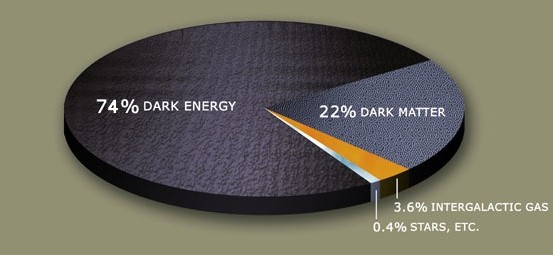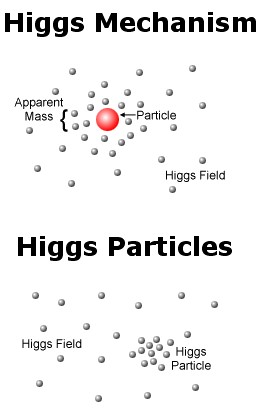
|
Main Topics > The Big Bang and the Big Crunch > Accelerating Universe and Dark Energy
Like dark matter, cosmic inflation (even if it is not actually proven beyond all doubt) is now usually seen as part of the standard Big Bang theory, and to some extent the two additional concepts rescue the Big Bang theory from being completely untenable. However, other potential problems still remain. The universe has continued to expand since the Big Bang, albeit at a slower rate since the period of inflation, while at the same time the gravity of all the matter in the universe is working to slow down and eventually reverse the expansion. Two main possibilities therefore present themselves: either the universe contains sufficient matter (known as the "critical mass") for its gravity to reverse the expansion, causing the universe to collapse back to what has become known as the “Big Crunch”, a kind of mirror image of the initial Big Bang; or it contains insufficient matter and it will go on expanding forever. According to General Relativity, the density parameter, Omega, which is defined as the average density of the universe divided by the critical density (i.e. that required for the universe to have zero curvature) is related to the curvature of space. If Omega equals 1, then the curvature is zero and the universe is flat; if Omega is greater than 1, then there is positive curvature, indicating a closed or spherical universe; if Omega is less than 1, then there is negative curvature, suggesting an open or saddle-shaped universe. The cosmic inflation model hypothesizes an Omega of exactly 1, so that the universe is in fact balanced on a knife’s edge between the two extreme possibilities. In that case, it will continue expanding, but gradually slowing down all the time, finally running out of steam only in the infinite future. For this to occur, though, the universe must contain exactly the critical mass of matter, which current calculations suggest should be about five atoms per cubic meter (equivalent to about 5 x 10-30 g/cm3).
This perhaps sounds like a tiny amount (indeed it is much closer to a perfect vacuum than has ever been achieved by scientists on Earth), but the actual universe is, on average, much emptier still, with around 0.2 atoms per cubic meter, taking into account visible stars and diffuse gas between galaxies. Even including dark matter in the calculations, all the matter in the universe, both visible and dark, only amounts to about a quarter of the required critical mass, suggesting a continuously expanding universe. However, in 1998, two separate teams of astronomers observing distant type 1a supernovas (one led by the American Saul Perlmutter and the other by the Australians Nick Suntzeff and Brian Schmidt) made parallel discoveries which threw the scientific community into disarray, and which also has important implications for the expanding universe and its critical mass. The faintness of the supernova explosions seemed to indicate that they were actually further away from the Earth than had been expected, suggesting that the universe’s expansion had actually speeded up (not slowed) since the stars exploded. Contrary to all expectations, therefore, the expansion of the universe actually seems to be significantly speeding up - we live in an accelerating universe! The only thing that could be accelerating the expansion (i.e. more than countering the braking force of the mutual gravitational pull of the galaxies) is space itself, suggesting that perhaps it is not empty after all but contains some strange “dark energy” or “antigravity” currently unknown to science. Thus, even what appears to be a complete vacuum actually contains energy in some currently unknown way. In fact, initial calculations (backed up by more recent research such as that on the growth of galaxy clusters by NASA's Chandra x-ray space telescope and that on binary galaxies by Christian Marinoni and Adeline Buzzi of the University of Provence) suggest that fully 73 - 74% of the universe consists of this dark energy.
If 74% of the total mass of the universe consists of dark energy, and about 85% of the remaining actual matter (representing about 22% of the total) is dark matter (see the section on Dark Matter for more discussion of this), then this suggests that only around 4% of the universe consists of what we think of as "normal", everyday, atom-based matter such as stars, intergalactic gas, etc. As of 2013, based on cosmic microwave background radiation data from the Planck satellite, the latest figures are closer to 68%, 27% and 5% respectively. Nowadays, this is generally accepted as the "standard model" of the make-up of the universe. So, for all our advances in physics and astronomy, it appears that we can still only see, account for, and explain a small proportion of the totality of the universe, a sobering thought indeed. Incorporating dark energy into our model of the universe would neatly account for the "missing" three-quarters of the universe required to cause the observed acceleration in the revised Big Bang theory. It also makes the map of the early universe produced by the WMAP probe fit well with the currently observed universe. Carlos Frenk's beautiful 3D computer models of the universe resemble remarkably closely the actual observed forms in the real universe (taking dark matter and dark energy into account), even if not all scientists are convinced by them. Alternative theories, such as Mordehai Milgrom's idea of "variable gravity", are as yet poorly developed and would have the effect of radically modifying all of physics from Newton onwards. So dark energy remains the most widely accepted option. Further corroboration of some kind of energy operating in the apparent vacuum of space comes from the Casimir effect, named after the 1948 experiments of Dutch physicists Hendrik Casimir and Dirk Polder. This shows how smooth uncharged metallic plates can move due to energy fluctuations in the vacuum of empty space, and it is hypothesized that dark energy, generated somehow by space itself, may be a similar kind of vacuum fluctuation. Unfortunately, like dark matter, we still do not know exactly what this dark energy is, how it is generated or how it operates. It appears to produce some kind of a negative pressure which is distributed relatively homogeneously in space, and thereby exerts a kind of cosmic repulsion on the universe, driving the galaxies ever further apart. As the space between the galaxies inexorably widens, the effects of dark energy appears to increase, suggesting that the universe is likely to continue expanding forever, although it seems to have little or no influence within the galaxies and clusters of galaxies themselves, where gravity is the dominant force. Although no-one has any idea of what dark energy may actually be, it appears to be unsettlingly similar to the force of cosmic repulsion or “cosmological constant” discarded by Einstein back in 1929 (as mentioned in the section on The Expanding Universe and Hubble’s Law), and this remains the most likely contender, even if its specific properties and effects are still under intense discussion. The size of the cosmological constant needed to describe the accelerating expansion of our current universe is very small indeed, around 10-122 in Planck units. Indeed, the very closeness of this to zero (without it actually being zero) has worried many scientists. But even a tiny change to this value would result in a very different universe indeed, and one in which life, and even the stars and galaxies we take for granted, could not have existed. Perhaps equally worrying is the colossal mismatch between the infinitesimally small magnitude of dark energy, and the value predicted by quantum theory, our best theory of the very small, as to the energy present in apparently empty space. The theoretical value of dark energy is over 10120 times smaller than this, what some scientists have called the worst failure of a prediction in the history of science! Some scientists have taken some comfort about the unexpectedly small size of dark energy in the idea that ours is just one universe in an unimaginably huge multiverse. Out of a potentially infinite number of parallel universes, each with slightly different properties and dark energy profiles, it is not so unlikely that ours just happens to be one with a dark energy that allows for the development of stars and even life, an example of the anthropic principle.
There has been some speculation that dark energy may be connected to the still little understood Higgs field. According to the theoretical work of the English physicist Peter Higgs and others in the 1960s, the vacuum of space is actually permeated by what has become known as a Higgs field. It is the interactions with this field that gives the other elementary particles their mass, as it stops them from flying off at the speed of light by clustering around them and impeding their progress. Excitations of the Higgs field form particles known as Higgs bosons, an essential component of the current Standard Model of particle physics. Up until 2012, though, such a particle remained entirely theoretical and unproven. But experiments in 2012, at the Large Hadron Collider at CERN, were finally able to create and isolate a particle which gives every indication of being the elusive Higgs boson, although more detailed tests are still ongoing. Another possible candidate for dark energy arises from the theoretical work on supersymmetry, which effectively doubles the number of elementary particles in the current Standard Model with the postulation of massive unknown “super-partners” for each particle, whose spin differs by ½. Yet other candidates are so-called “quintessence” and so-called “phantom energy”, although these ideas are essentially still at the hypothesis stage. Neither is it clear whether the effects of dark energy are constant or changing over time, although research using data from the Hubble Space Telescope suggests that it was already at work boosting the expansion of the universe as much as nine billion years ago.
|
Back to Top of Page
Introduction | Main Topics | Important Dates and Discoveries | Important Scientists | Cosmological Theories | The Universe By Numbers | Glossary of Terms | A few random facts | Blog | Gravitational Lensing Animation | Angular Momentum Calculator | Big Bang Timeline
NASA Apps - iOS | Android
The articles on this site are © 2009-.
If you quote this material please be courteous and provide a link.
Citations | Sources | Privacy Policy


